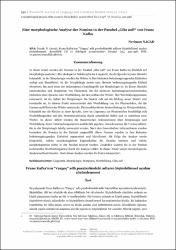| dc.contributor.author | Nacak, Neriman | |
| dc.date.accessioned | 2022-05-11T14:28:20Z | |
| dc.date.available | 2022-05-11T14:28:20Z | |
| dc.date.issued | 2019 | |
| dc.identifier.issn | 2148-7782 | |
| dc.identifier.issn | 2148-9599 | |
| dc.identifier.uri | https://doi.org/10.29000/rumelide.580704 | |
| dc.identifier.uri | https://app.trdizin.gov.tr/makale/TXprNE5UQTNOdz09 | |
| dc.identifier.uri | https://hdl.handle.net/20.500.11776/6780 | |
| dc.description.abstract | In dieser Arbeit wurden die Nomina in der Parabel „Gibs auf!“ von Franz Kafka im Hinblick auf Morphologie analysiert. Morphologie ist Teildisziplin der Linguistik, die die Sprache in jeder Hinsicht behandelt. In der Morphologie werden die Wörter in ihre kleinsten bedeutungstragenden Einheiten zerlegt und klassifiziert. In der Morphologie nennt man kleinste bedeutungstragende Einheit Morphem, das auch einer der bedeutsamen Grundbegriffe der Morphologie ist. In dieser Hinsicht unterscheiden sich Morpheme von Phonemen, die die kleinsten bedeutungsunterscheidenden Einheiten einer Sprache sind. Wortbildung, die den Aufbau der Wörter, ihre Wortbildungsprozesse untersucht, ist ein Gebiet der Morphologie. Sie bezieht sich auf die Bildung neuer Wörter und beschreibt sie. In diesem Punkt unterscheidet sich Wortbildung von der Flexionslehre, die die Formen und Flexion der Wörter untersucht. Flexionslehre leistet keinen Beitrag zur Wortproduktion, behandelt nur die Flexion in einer Sprache. Aber im Gegensatz zur Flexionslehre beschäftigt sich Wortbildungslehre mit den Wortproduktionen durch sprachliche Mittel und so entstehen neue Wörter. In dieser Arbeit wurden die theoretischen Informationen über Morphologie und Wortbildung, ihren Untersuchungsbereich ausführlich gegeben. Danach wurden die Termini erklärt, die in der Morphologie häufig verwendet werden. Nach den theoretischen Informationen wurden besonders die Nomina in der Parabel ausgewählt. Diese Nomina wurden in ihre kleinsten bedeutungstragenden Einheiten segmentiert und klassifiziert. Als Folge der Analyse wurde festgestellt, welche morphologischen Eigenschaften die Nomina besitzen und welche morphologischen Mittel in der Parabel benutzt wurden. Zusätzlich wurden die in der Parabel bestehenden Wortbildungsarten durch die Analyse erklärt. In dieser Arbeit wurde morphologische Analysemethode benutzt. Nach dieser Analyse wurden die Daten interpretiert. | en_US |
| dc.description.abstract | Bu çalışmada Franz Kafka‘nın "Vazgeç" adlı parabolündeki adlar biçimbilim açısından incelenmiştir. Biçimbilim, dili her yönüyle ele alan dilbilimin bir alt alanıdır. Biçimbilimde sözcükler anlamlı en küçük parçalarına kadar ayrılır ve sınıflandırılır. Söz konusu anlamlı en küçük parça, biçimbilimde biçimbirim olarak adlandırılır ve biçimbilimin önemli temel kavramlarından biridir. Bu bakımdan biçimbirim, bir dilin anlam ayırıcı en küçük parçası olan sesbirimden ayrılır. Sözcüklerin yapısını, sözcük yapım süreçlerini araştıran sözcük yapımı da biçimbilimin bir alanıdır. Sözcük yapımı, yeni sözcüklerin oluşumları ile ilgilenir ve onları betimler. Bu noktada sözcük yapımı, sözcüklerin çekimleri ve biçimleri ile ilgilenen çekimsel biçimbilimden ayrılır. Çekimsel biçimbilim sözcük üretimini ele almaz, sadece bir dildeki çekimlerle uğraşır. Ancak çekimsel biçimbilimin aksine sözcük yapımı ise, sözcük üretimi ile ilgilenir ve böylelikle de yeni sözcükler oluşur. Bu çalışmada öncelikle biçimbilim ile sözcük yapımı hakkında ve konu alanı ile ilgili kuramsal bilgiler detaylı olarak verilmiştir. Ayrıca biçimbilimde çok sık kullanılan terimler açıklanmıştır. Kuramsal bilgilerden sonra özellikle paraboldeki adlar seçilmiştir. Bu adlar anlam taşıyan en küçük parçalarına kadar ayrılmış ve sınıflandırılmıştır. Çalışmanın sonucu olarak paraboldeki adların hangi biçimbilimsel özellikleri taşıdıkları, adlarda hangi biçimbilimsel araçların kullanıldığı tespit edilmiştir. Ek olarak parabolde bulunan sözcük yapım türleri de çözümlemeye göre açıklanmıştır. Bu çalışmada biçimbilimsel çözümleme yöntemi kullanılmıştır. Yapılan incelemeye göre de veriler değerlendirilmiştir.;This study morphologically examines the nouns in Franz Kafka’s parable entitled “Give It Up!”. Morphology is a subfield of linguistics, which deals with every aspect of language. Words in morphology are separated and classified to the smallest meaningful pieces. These smallest meaningful pieces are named morphemes in morphology and are one of the important, fundamental concepts of morphology. Morphemes in this regard are distinct from phonemes, which are a language’s smallest pieces that separate meaning. Word formation researches the structure of words and the processes of word formation and is a field of morphology. Word formation relates to the formation of new words and defines them. Word formation at this point is separated from inflectional morphology, which relates to the declensions and forms of words. However, contrary to inflectional morphology, word formation relates to word production, thus new words form. This study provides detailed, theoretical information about word formation and the subject area, primarily with morphology. The terms most frequently used in morphology are also explained. The nouns in the parable were chosen after the theoretical information. These nouns were separated into the smallest pieces that carry meaning and were classified. As a result of the study, it was determined which morphological characteristics the nouns in the parable carry and which morphological tools were used in the nouns. Additionally, the types of word formation found in the parable were explained based on the analysis. This study used the morphological analysis method. The data were evaluated based on the conducted research. | en_US |
| dc.language.iso | ger | en_US |
| dc.identifier.doi | 10.29000/rumelide.580704 | |
| dc.rights | info:eu-repo/semantics/openAccess | en_US |
| dc.title | Eine morphologische Analyse der Nomina in der Parabel „Gibs auf!" von Franz Kafka | en_US |
| dc.title.alternative | Franz Kafka'nın "Vazgeç" adlı parabolündeki adların biçimbilimsel açıdan çözümlenmesi;A morphological analysis of the nouns in Franz Kafka's parable titled "Give it up!" | en_US |
| dc.type | article | en_US |
| dc.relation.ispartof | RumeliDE Dil ve Edebiyat Araştırmaları Dergisi | en_US |
| dc.department | Fakülteler, Fen Edebiyat Fakültesi, Alman Dili ve Edebiyatı Bölümü | en_US |
| dc.identifier.volume | 0 | en_US |
| dc.identifier.issue | 15 | en_US |
| dc.identifier.startpage | 450 | en_US |
| dc.identifier.endpage | 458 | en_US |
| dc.institutionauthor | Nacak, Neriman | |
| dc.identifier.trdizinid | TXprNE5UQTNOdz09 | en_US |



















